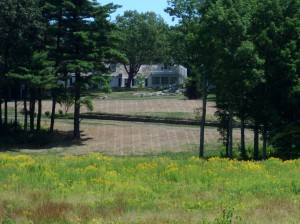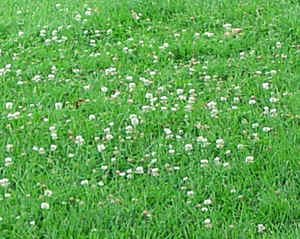Healthy Lawn Basics
What is a healthy lawn? It’s a lawn that grows without frequent applications of chemicals, organic or otherwise. It’s a lawn that provides the owner with a place to walk, to play or highlights the other features in the landscape. It is probably lush and green in the spring and fall. During the hot, dry days of summer it may be brown, having gone dormant.

Acres and acres of parched lawn in Dover, MA – with the healthier alternative right there in front of them
But let’s start at the beginning. The Great American lawn should be called the Great English Lawn. The grasses we grow are not native to the Americas but imported from Eurasia. They do wonderfully well in England where long cool, wet summers provide them with exactly the growing conditions they need. And it is from England that we imported the idea of the lawn surrounding great estates. It was a sign of wealth, and as Americans became wealthy they too wanted the prestige of unused fields kept trimmed by men with shears.
By the last quarter of the 19th century, the invention of the reel mower meant the middle class could have a lawn around their homes. No longer were lawns solely for those with corps of gardeners. Over time, the vegetable, herb and flower gardens that once dominated the area around the house, gave way to grass.
The typical lawn was filled with clover which naturally takes nitrogen, one of the major components of lawn fertilizers, from the air and makes it available to other plants. Weeds were accepted, or dealt with by hand, one by one. But after World War II that all changed. Commercial fertilizers and weed killers became available. Because the herbicides (weed killers) kill clover, marketing campaigns began to convince the homeowner that clover was not good for the lawn. And so it too is killed alongside the dandelions and creeping Charlie.
Today we start in early spring putting down a fertilizer to get the grass greener, quicker. That is followed by a pre-emergent designed to keep weed seeds from sprouting. A great idea if you manage to put the pre-emergent down at the correct time—after the soil has reached the proper temperature for the seeds to germinate and before that actually happens. In mid-spring add more fertilizer because what went on a month ago has been washed deep into the soil, or off the lawn altogether by spring rains. But be certain to use weed and feed to kill any broadleaf weeds that were missed by the pre-emergents. Once summer comes, lawns want to go dormant in New England. To avoid that, feed again and water and water and water. And now is the time to put down insect control to kill any “bugs’ that may be living in your lawn. Finally autumn arrives, the cooler temperatures and rain resurrect the lawn. But your work isn’t finished. The lawn care professionals say add a fall fertilizer to prepare for winter. Come winter, you may rest.
Organic lawn care also requires frequent applications of organic fertilizers, pre-emergents and so forth. They too can pollute waterways and the environments, even be deadly to wildlife. But what do you really need to do to have a friendly healthy lawn? First lose the preconception that a home lawn should look like a golf course. The average new England lawn is 15,000 sq ft. It requires a minimum of 40 hours a year of mowing and will produce two tons of clippings if you bag them. At a time of water bans everywhere, lawn watering accounts for one-third of all water use.
